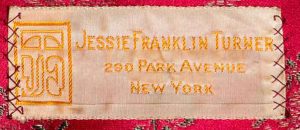Jessie Franklin Turner (1881-1956) was a pioneering American fashion designer who made significant contributions to the development of the American fashion industry in the early 20th century. Personally, she was an enigmatic and illusive figure, rarely photographed and with some discrepancies remaining about details of her life.
During her teenage years, Turner worked at a lingerie store, where she proposed ideas for improving the quality and selection of the merchandise to the owner. From there, she became a buyer for the lingerie department at the St. Louis-based department store, Scruggs, Vandervoort and Barney. In 1908, Turner was recruited as the European buyer for McCutcheon & Co.’s “The Linen Store,” a position that allowed her to expand her knowledge of lingerie and textiles.
Paul Bonwit hired Turner as a European and Oriental goods buyer for Bonwit Teller between 1916 and 1918. During this time, she was also sent to the Philippines to oversee a handmade lingerie factory. In 1918, Turner started designing for Bonwit Teller’s custom salon under the name Winifred Warren Inc. The following year, her designs were showcased at the American Museum of Natural History’s Exhibition of Industrial Art in Textiles and Costumes.
Turner established her own couture business in New York City in 1923, becoming one of the first American designers to create original designs rather than imitating Parisian fashions. Her fashions were known for their draped silhouettes, often achieved through direct draping of fabric onto the model. Turner was particularly renowned for her tea gowns, which were inspired by negligee and home wear but adapted for public wear. Her use of exotic and rare fabrics, often woven to her specifications and dyed according to her own formula, added to the distinctive character of her designs. She acknowledged the impact of historical and ethnographic (primarily Asian) textiles from the collection of the Brooklyn Museum.
Throughout her career, Turner’s designs were featured in prominent fashion publications, including Vogue, and were favored by wealthy American women. Her designs reflected a deep understanding of the relationship between fashion and the wearer’s personal space. As noted in a 1936 Vogue advertisement, Turner took great pleasure in designing garments that complemented a woman’s own drawing room, underscoring her attention to the broader context of fashion. She retired in 1942.
Note on Turner’s shop locations (all in New York City):
In 1922 Turner was at 290 Park Avenue
By 1932 her shop was at 23 East 67th Street
In 1936 she relocated to 410 Park Avenue
Written by denisebrain

